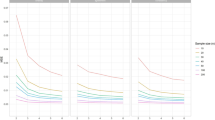Abstract
Bioequivalence trials compare the relative bioavailability of different formulations of a drug. Regulatory requirements for demonstrating average bioequivalence of two formulations generally include showing that a (say) 90% confidence interval for the ratio of expected pharmacologic end point values of the formulations lies between specified end points, e.g., 0.8–1.25. The likelihood of demonstrating bioequivalence when the formulations truly are equivalent depends on the sample size and on the variability of the pharmacologic end point. Group sequential bioequivalence testing provides a statistically valid way to accommodate misspecification of the variability in designing the trial by allowing for additional observations if a clear decision to accept or reject bioequivalence cannot be reached with the initial set of observations. This paper describes group sequential bioequivalence designs applicable in most practical situations that allow a decision to be reached with fewer observations than fixed-sample designs about 60% of the time at approximately the same average cost. The designs can be used in trials where the formulations are expected to have equal bioavailability and in trials where the formulations are expected to differ slightly. Data analyses are carried out exactly as for fixed-sample designs. Providing the capability of sequential decisions modestly affects the nominal significance levels, e.g., the required confidence level may be 93–94% instead of 90%.
Similar content being viewed by others
References
S. Durrleman and R. Simon. Planning and monitoring of equivalence trials.Biometrics 46:329–336 (1990).
D. J. Schuirmann. On hypothesis testing to determine if the mean of a normal distribution is contained in a known interval.Biometrics 37:617 (1981).
D. J. Schuirmann. A comparison of the two one-sided test procedure and the power approach for assessing the equivalence of average bioavailability.J. Pharmacokin. Biopharm. 15:657–680 (1987).
W. J. Westlake. Use of confidence intervals in analyses of comparative bioavailability trials.J. Pharm. Sci. 61:1340–1341 (1972).
W. J. Westlake. Symmetrical confidence intervals for bioequivalence trials.Biometrics 32:741–744 (1976).
W. J. Westlake. Statistical aspects of comparative bioavailability trials.Biometrics 35:273–280 (1979).
D. Mandallaz and J. Mau. Comparison of different methods for decision-making in bioequivalence assessment.Biometrics 37:213–222 (1981).
A. Racine-Poon, A. Grieve, H. Fluehler, and A. F. M. Smith. A two-stage procedure for bioequivalence studies.Biometrics 43:847–856 (1987).
B. E. Rodda and R. L. Davis. Determining the probability of an important difference in bioavailability.Clin. Pharmacol. Ther. 28:247–252 (1980).
R. Srinivasan and P. Langenberg. A two-stage procedure with controlled error probabilities for testing bioequivalence.Biomet. J. 28:825–833 (1986).
C. Jennison and B. W. Turnbull. Sequential equivalence testing and repeated confidence intervals, with applications to normal and binary responses.Biometrics 49:31–43 (1993).
D. M. Rocke. On testing for bioequivalence.Biometrics 40:225–230 (1984).
S. Chow and J. P. Liu.Design and Analysis of Bioavailability and Bioequivalence Studies, Marcel Dekker, New York, 1992.
M. Hills and P. Armitage. The two period cross-over clinical trial.Br. J. Clin. Pharmacol. 8:7–20 (1979).
B. Jones and M. G. Kenward.Design and Analysis of Cross-Over Trials, Chapman and Hall, London, 1989.
D. J. Schuirmann. Design of bioavailability/bioequivalence studies.Drug Inform. J. 24:315–323 (1990).
J. Liu and S. Chow. Sample size determination for the two one-sided tests procedure in bioequivalence.J. Pharmacokin. Biopharm. 20:101–104 (1992).
C. Jennison and B. W. Turnbull. Interim analysis: the repeated confidence interval approach (with discussion).J. Roy. Statis. Soc. SeriesB 51:305–361 (1989).
C. Jennison and B. W. Turnbull. Exact calculations for sequentialt, X 2 andF tests.Biometrika 78:133–141 (1991).
E. V. Slud and L. J. Wei. Two-sample repeated significance tests based on the modified Wilcoxon statistic.J. Am. Statist. Assoc. 77:855–861 (1982).
K. Kim and D. L. Demets. Design and analysis of group sequential tests based on the Type I error spending rate function.Biometrika 74:149–154 (1987).
A. L. Gould and V. J. Pecore. Group sequential methods for clinical trials allowing early acceptance ofH o and incorporating costs.Biometrika 69:75–80 (1982).
A. L. Gould. Planning and revising the sample size for a trial.Statist. Med. 14:1039–1051 (1995).
E. J. Dudewicz. Confidence intervals for power, with special reference to medical trials.Aust. J. Stat. 14:211–216 (1972).
E. Diletti, D. Hauschke, and V. W. Steinijans. Sample size determination for bioequivalence assessment by means of confidence intervals.Int. J. Clin. Pharmacol. Ther. Toxicol. 29:1–8 (1991).
D. Hauschke, V. W. Steinijans, E. Diletti, and M. Burke. Sample size determination for bioequivalence assessment using a multiplicative model.J. Pharmacokin. Biopharm. 20:557–561 (1992).
S. Emerson and T. R. Fleming. Parameter estimation following group sequential hypothesis testing.Biometrika 77:875–892 (1990).
W. H. Press, B. P. Flannery, S. A. Teukolsky, and W. T. Vetterling.Numerical Recipes in Pascal, Cambridge University Press, Cambridge, 1989.
S. Anderson and W. W. Hauck. Consideration of individual bioequivalence.J. Pharmacokin. Biopharm. 18:259–273 (1990).
G. Ekbohm and H. Melander. The subject-by-formulation interaction as a criterion of interchangeability of drugs.Biometrics 45:1249–1254 (1989).
D. J. Holder and F. Hsuan. Moment-based criteria for determining bioequivalence.Biometrika 80:835–846 (1993).
S. Hwang, P. B. Huber, M. Hesney, and K. C. Kwan. Bioequivalence and interchangeability.J. Pharm. Sci. 67:IV (1978).
M. H. Gail, D. L. Demets, and E. V. Slud, in R. Johnson and J. Crowley (eds.),Survival Analysis, Monograph Series 2, IMS Lecture Notes, Hayward, CA, 1981. p. 287–301.
E. V. Slud. Sequential linear rank tests for two-sample censored survival data.Ann. Statist. 12:551–571 (1984).
D. Demets and M. H. Gail. Use of logrank tests and group sequential methods at fixed calendar times.Biometrics 41:1039–1044 (1985).
K. K. G. Lan and D. L. Demets. Discrete sequential boundaries for clinical trials.Biometrika 70:659–663 (1983).
Author information
Authors and Affiliations
Rights and permissions
About this article
Cite this article
Gould, A.L. Group sequential extensions of a standard bioequivalence testing procedure. Journal of Pharmacokinetics and Biopharmaceutics 23, 57–86 (1995). https://doi.org/10.1007/BF02353786
Received:
Accepted:
Published:
Issue Date:
DOI: https://doi.org/10.1007/BF02353786




